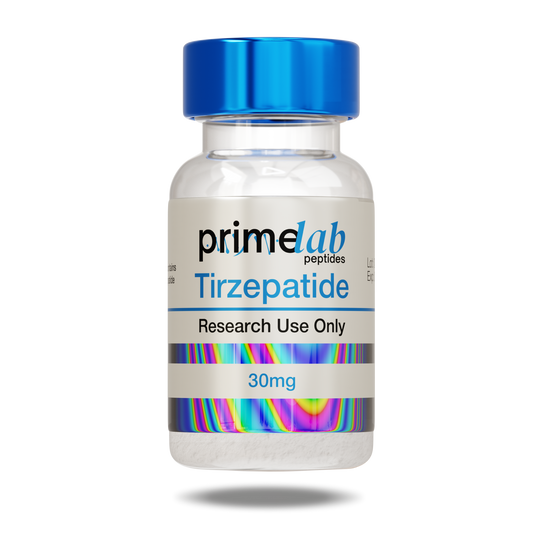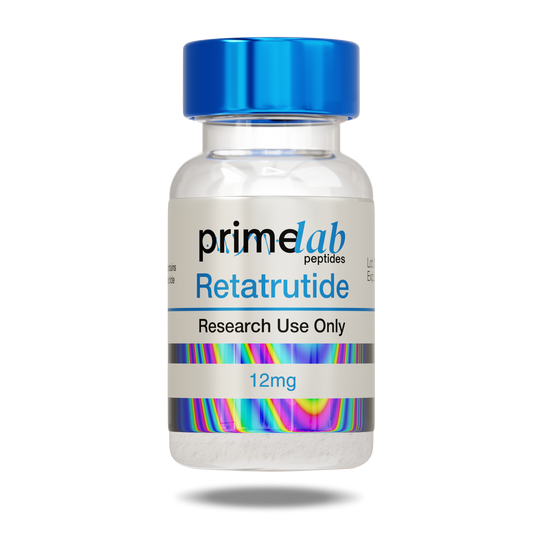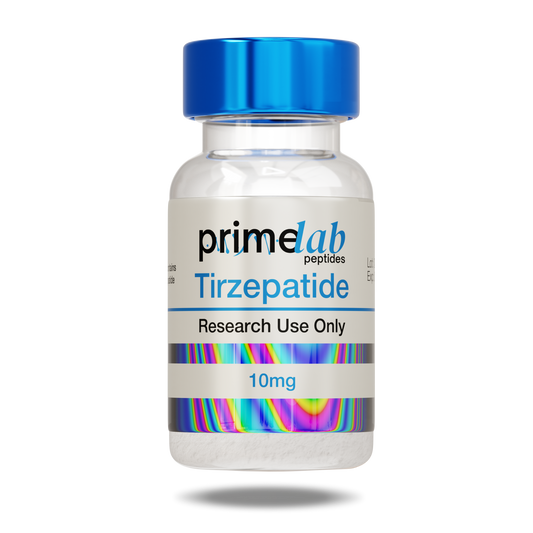All product descriptions and articles provided on this website are intended strictly for informational and educational purposes. Our products are designed exclusively for in-vitro research (i.e., experiments conducted outside of a living organism, typically in glassware such as test tubes or petri dishes). These compounds are not approved by the FDA for use in humans or animals. They are not medications, nor are they intended to diagnose, treat, prevent, or cure any disease or medical condition. Any bodily administration-human or animal-is strictly prohibited by law. Our products are not for human consumption under any circumstances.

Clinical studies have revealed that tirzepatide enhances fat loss and insulin sensitivity by dual-activating GIP and GLP-1 receptors. Moreover, this dual mechanism optimizes glucose utilization and energy balance at the cellular level. Consequently, it improves adipose tissue metabolism, leading to more efficient lipid breakdown. Ultimately, research findings emphasize that these coordinated effects collectively strengthen insulin signaling in experimental conditions.
At Prime Lab Peptides, we support researchers by providing high-quality tirzepatide and other research-grade peptides designed for laboratory use only. Our commitment to purity, consistency, and scientific integrity helps investigators overcome experimental challenges. With Prime Lab Peptides, researchers can explore complex metabolic pathways confidently and generate reproducible, data-driven results.
How Does Tirzepatide Mechanistically Enhance Fat Loss Clinically?
Tirzepatide enhances fat loss by activating both GLP-1 and GIP receptors, which stimulate insulin secretion and regulate glucose metabolism. As noted by the NCBI[1], this dual incretin mechanism delays gastric emptying, suppresses glucagon, and promotes energy balance, thereby supporting improved fat utilization and healthier body composition in clinical studies.
Key mechanisms include:
- Appetite suppression leading to lower caloric intake.
- Enhanced thermogenesis increases total energy expenditure.
-
Improved adipocyte function supporting healthier fat metabolism.
Moreover, clinical studies demonstrate that tirzepatide reduces both visceral and subcutaneous fat, showing measurable metabolic improvements. Overall, these findings highlight its ability to promote targeted fat reduction and favorable fat redistribution in controlled research environments.
How Does Tirzepatide’s Impact on Beta-Cell Function Contribute to Metabolic Improvement?
Tirzepatide improves metabolic function by enhancing pancreatic beta-cell function, resulting in more balanced insulin secretion and improved glucose control. As reported by the Journal of Clinical Endocrinology & Metabolism[2], tirzepatide improved markers of insulin sensitivity and beta-cell function beyond the effects of weight loss, highlighting its distinct mechanisms for advanced glycemic regulation.
The following mechanisms explain how tirzepatide strengthens beta-cell performance:
- Enhanced glucose-stimulated insulin secretion: Tirzepatide amplifies the beta cells’ response to glucose, ensuring timely insulin release and improving overall glycemic control under metabolic stress.
- Protection against beta-cell apoptosis: It reduces oxidative stress and inflammatory damage, safeguarding beta-cell integrity and helping maintain functional cell populations within the pancreas.
- Promotion of beta-cell proliferation: Tirzepatide stimulates cellular renewal and regeneration, sustaining healthy beta-cell mass and supporting long-term insulin production efficiency.

What Is the Clinical Evidence for Tirzepatide Improving Insulin Sensitivity?
Tirzepatide improves insulin sensitivity through multiple biological pathways, as demonstrated in a study published by Oxford University[3] Press. Moreover, this effect extends beyond weight reduction, emphasizing metabolic adaptability. In this research, tirzepatide significantly reduced HOMA2-IR and fasting insulin levels while enhancing β-cell function (HOMA2-B). Consequently, these findings confirm tirzepatide’s robust ability to improve metabolic efficiency and glucose regulation in controlled clinical settings.
Furthermore, tirzepatide’s dual agonist activity on GLP-1 and GIP receptors restores insulin signaling in key tissues such as skeletal muscle and adipose cells. This restoration promotes better glucose uptake and utilization. Consequently, the peptide exhibits robust and reproducible insulin-sensitizing effects across diverse clinical studies. Overall, research findings consistently highlight tirzepatide’s potential for advancing metabolic research and experimental exploration.
What Are the Weight-Independent Effects of Tirzepatide on Metabolic Health?
Tirzepatide exerts weight-independent effects on metabolic health by enhancing insulin sensitivity and energy metabolism. As reported by the Journal of Clinical Investigation[4], tirzepatide increases glucose, fatty acid, and amino acid oxidation in brown adipose tissue. These effects highlight distinct GIP receptor–mediated pathways that function beyond weight loss.
Together, these effects reveal tirzepatide’s broad metabolic potential:
1. Enhanced Muscle Glucose Utilization
Tirzepatide directly improves glucose uptake in skeletal muscle by strengthening insulin receptor sensitivity. This leads to more efficient glucose transport and energy use, even without significant weight changes.
2. Anti-Inflammatory Effects in Adipose Tissue
It reduces inflammatory signaling within adipose cells, minimizing metabolic stress. Consequently, this anti-inflammatory response contributes to better insulin action and overall tissue homeostasis independent of body mass reduction.
3. Modulation of Lipid Metabolism
Tirzepatide optimizes lipid breakdown and utilization, reducing circulating triglycerides. This modulation improves insulin sensitivity and supports metabolic flexibility, highlighting an advanced mechanism distinct from weight-related metabolic improvements.
Drive Scientific Discovery Forward with Tirzepatide from Prime Lab Peptides
Researchers exploring metabolic pathways often face challenges, including limited peptide purity, inconsistent compound performance, and difficulty reproducing experimental results. Moreover, sourcing reliable, research-grade materials that meet stringent laboratory standards can compromise data accuracy and hinder progress in understanding complex biological mechanisms, such as glucose regulation and fat metabolism.
At Prime Lab Peptides, we supply research-grade Tirzepatide designed for consistency, purity, and reproducibility in laboratory studies. Moreover, our peptides undergo strict quality verification to ensure dependable experimental outcomes. This commitment allows researchers to explore complex metabolic pathways with greater precision. For collaboration or inquiries, contact us to support your future study.

FAQs
How Does Tirzepatide Regulate Glucose Metabolism?
Tirzepatide regulates glucose metabolism by activating both GLP-1 and GIP receptors. Moreover, this dual activation enhances glucose uptake and insulin efficiency. Consequently, it supports improved metabolic performance in controlled research environments.
What Methods Are Used to Measure Insulin Sensitivity?
Researchers assess tirzepatide’s insulin sensitivity through hyperinsulinemic-euglycemic clamp studies. Additionally, fasting insulin levels and HOMA-IR indices are evaluated. Together, these methods confirm tirzepatide’s consistent metabolic effects across various research trials.
How Does Tirzepatide Affect Adipose Tissue Function?
Tirzepatide affects adipose tissue function by promoting lipolysis and reducing inflammation. Furthermore, it enhances adipocyte metabolism and lipid turnover. As a result, these effects contribute to improved energy regulation in research-based metabolic studies.
What Are the Cellular Benefits of Beta-Cell Preservation?
The cellular benefits of beta-cell preservation include maintaining insulin secretion and glucose stability. Moreover, tirzepatide supports beta-cell regeneration while minimizing apoptosis. Consequently, these mechanisms help sustain optimal pancreatic activity in controlled laboratory research.




